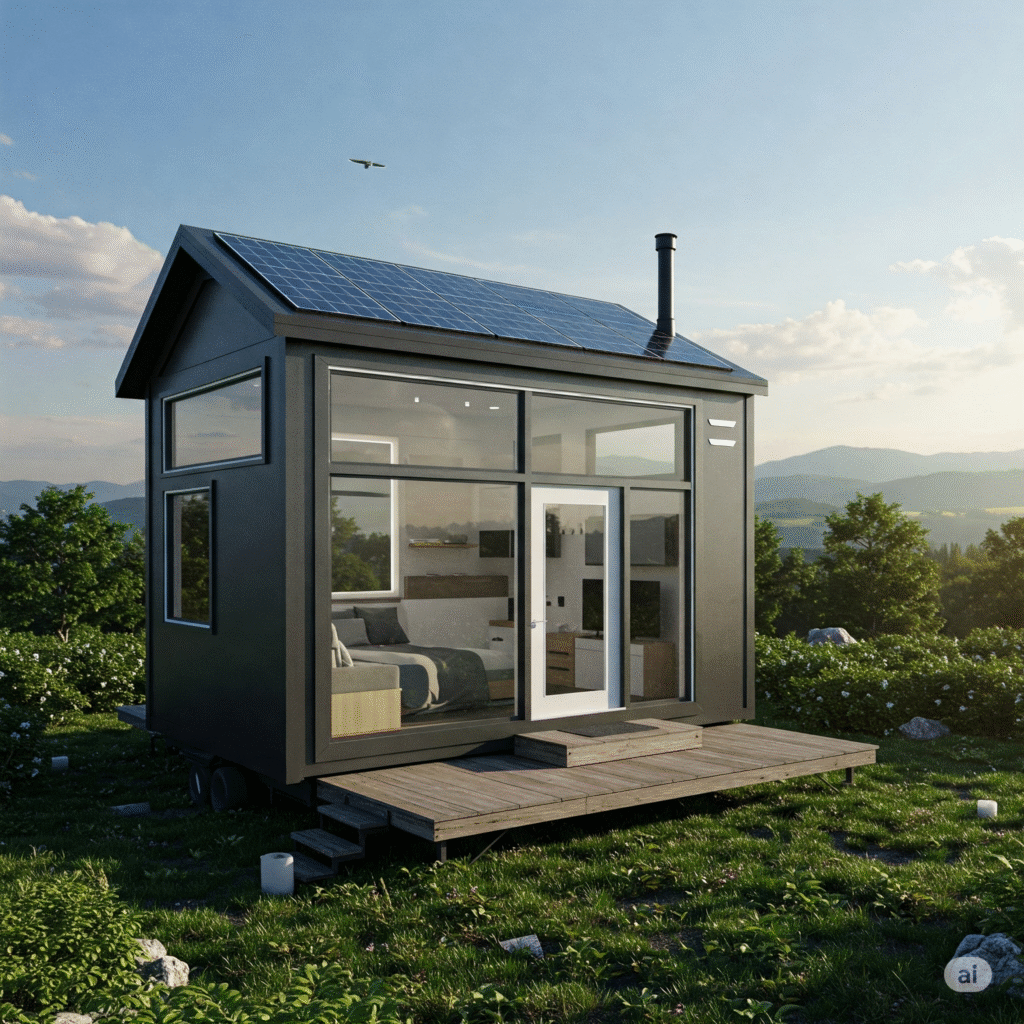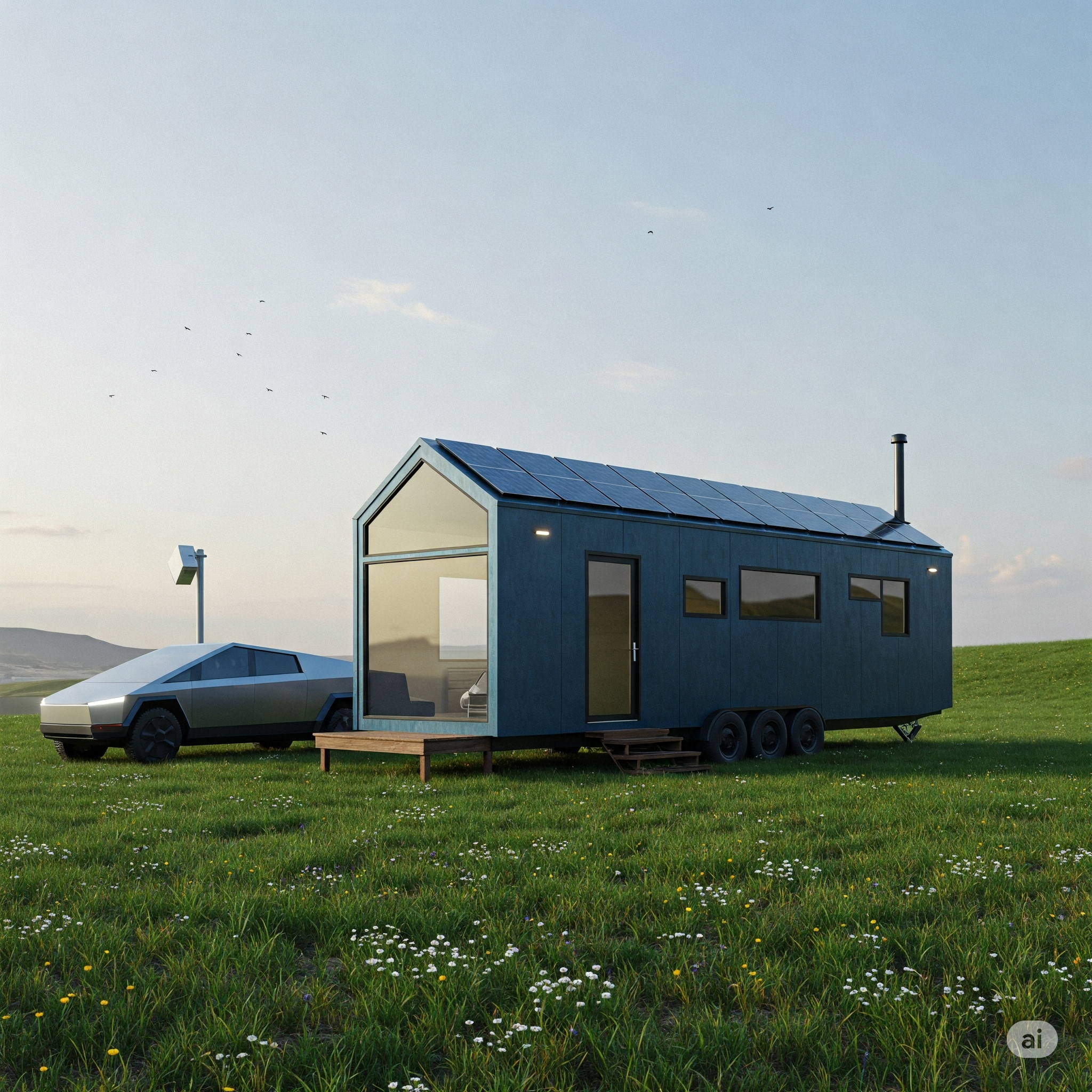Introduction Revolutionizing Modern Living with the Tesla Tiny House
The Tesla Tiny House represents more than just an innovative structure—it symbolizes a revolutionary shift in how we think about energy, sustainability, and the spaces we call home. In an age where minimalism and environmental consciousness are growing trends, Tesla has merged technology and eco-living in one mobile, solar-powered solution. The tiny house movement itself has been gaining traction for over a decade, but the addition of Tesla’s energy expertise has taken it to a new frontier.
Tiny homes are typically small, transportable dwellings designed to reduce carbon footprints and encourage simpler living. Tesla’s version goes beyond that by integrating its core energy products—solar panels and the Powerwall battery—into a sleek, modern design. This fusion creates a self-sufficient, mobile home that exemplifies Tesla’s mission: to accelerate the world’s transition to sustainable energy. Not only is it an architectural statement, but it’s also a bold challenge to the traditional housing industry.
Tesla Tiny House is more than just a concept; it’s a beacon of what’s possible when sustainability meets design and innovation. As energy crises and housing affordability continue to dominate global discourse, solutions like these push boundaries. With renewable energy, reduced consumption, and mobility all under one roof, the Tesla Tiny House invites individuals and families to imagine a future where eco-friendly living isn’t just attainable—it’s aspirational and stylish. Let’s explore what makes this mobile marvel a key part of Tesla’s sustainable legacy.
What is the Tesla Tiny House
The Tesla Tiny House is a mobile, fully sustainable structure that serves as a showcase for Tesla’s renewable energy products. It’s essentially a compact home built on a trailer, equipped with a complete off-grid power solution including solar panels, a Tesla Powerwall, and intelligent energy controls. Originally unveiled in Australia as part of a promotional tour, the Tesla Tiny House wasn’t intended as a mass-produced product. Instead, it was built to demonstrate how Tesla’s energy technologies can integrate seamlessly into daily life—even within a minimalistic footprint.
Measuring approximately 20 feet long and built from sustainable timber, the structure embodies a modern yet cozy aesthetic. The minimalist exterior is painted black, aligning with Tesla’s signature branding, while the interior boasts clever storage solutions, essential living amenities, and high energy efficiency. While relatively small, it serves as a complete living solution designed to highlight the potential of solar-powered, off-grid homes.
A key feature of the Tesla Tiny House is its educational value. As it toured major cities, the home allowed visitors to interact with Tesla’s energy interface via a mobile app, offering real-time insights into solar production and energy usage. Although it’s not currently for sale, the Tesla Tiny House has inspired architects, tiny home enthusiasts, and sustainability advocates worldwide. By integrating renewable energy into a tangible, livable format, Tesla effectively demonstrates that sustainability and innovation can coexist in even the smallest of spaces.
Tesla Energy Integration Technology Behind the Home

At the core of the Tesla Tiny House is its state-of-the-art energy system, powered entirely by Tesla’s renewable energy technology. The most prominent component is the Tesla Powerwall, a rechargeable lithium-ion battery designed to store solar energy generated by the rooftop panels. This allows the tiny house to operate completely off-grid, storing energy during the day and using it at night or during cloudy periods, ensuring a constant, reliable power supply.
The rooftop is fitted with Tesla solar panels that convert sunlight into electricity. These panels are not just functional but also stylish, aligning with Tesla’s design philosophy. Together with the Powerwall, they form a closed-loop energy system that minimizes reliance on fossil fuels. The energy produced powers lights, appliances, and even mobile devices within the house, making it a model of energy independence.
Tesla’s energy integration also includes a digital interface for real-time monitoring. Through the Tesla mobile app, users can track energy production, consumption, and storage. This level of transparency empowers users to optimize their usage and understand the direct impact of solar energy on their lifestyle. The Tesla Tiny House proves that cutting-edge technology doesn’t have to be confined to large-scale infrastructure—it can be scaled down to suit individuals and families who want to reduce their ecological footprint while maintaining modern conveniences.
Sustainable Living Benefits
The Tesla Tiny House isn’t just an engineering marvel—it’s a gateway to a sustainable lifestyle. Living in a solar-powered tiny house drastically reduces one’s carbon footprint, thanks to its reliance on clean, renewable energy and its minimalist approach to space and resources. Every element, from construction materials to energy systems, is designed with sustainability in mind, offering a lifestyle that aligns with environmental values without sacrificing comfort.
One major advantage of this setup is energy independence. Traditional homes depend on large utility grids that may rely on coal or natural gas. In contrast, the Tesla Tiny House generates and stores its own electricity, making it not only environmentally friendly but also resilient in times of power outages or emergencies. This level of autonomy is particularly appealing to off-grid enthusiasts and those looking to live in remote locations without sacrificing access to modern amenities.
Financial sustainability is another key benefit. While the initial cost of solar installations can be significant, the long-term savings on electricity bills can be substantial. Moreover, the small size of the home means lower expenses in terms of heating, cooling, and general maintenance. The minimalist lifestyle also encourages mindful consumption—less space translates to fewer material needs, which further reduces environmental impact.
By integrating mobility, renewable energy, and efficiency, the Tesla Tiny House offers a blueprint for the future. It’s not just a place to live; it’s a philosophy in action—a daily reminder that sustainable choices are not only possible but also practical and empowering.
Mobility and Design Aesthetics
The Tesla Tiny House combines sleek, futuristic aesthetics with practical mobility, offering a lifestyle that is as visually appealing as it is functional. Mounted on a trailer, the tiny house is fully transportable, enabling users to take their sustainable lifestyle on the road. Whether relocating for work, seeking adventure, or simply embracing nomadic living, this design supports the freedom to move without compromising comfort or energy access.
The exterior is modern and minimalistic, reflecting Tesla’s commitment to clean lines and refined simplicity. Made from locally-sourced, sustainable timber, the house is designed to blend functionality with eco-conscious beauty. Inside, the design maximizes every square inch. Multi-purpose furniture, fold-out beds, and smart storage solutions allow residents to enjoy a clutter-free living space that feels open and intentional.
The mobility factor is not just about travel—it also symbolizes freedom from traditional constraints. Homeowners are no longer tied to a single location or dependent on utility grids. Whether parked in a forest, by the beach, or in an urban setting, the Tesla Tiny House can adapt to different environments while maintaining its zero-emissions lifestyle.
Design-wise, Tesla has crafted a product that aligns with the values of sustainability, innovation, and modern elegance. The Tesla Tiny House proves that going green doesn’t mean sacrificing design or functionality—it’s about embracing a lifestyle that’s lighter on the planet while still being rich in experience and comfort.
Conclusion A Glimpse into a Smarter Smaller Future
The Tesla Tiny House encapsulates a bold vision for the future—a future where sustainability, technology, and mobility intersect. In a world grappling with climate change, energy scarcity, and housing crises, Tesla’s mobile solar home offers an inspiring, tangible solution. It challenges the norm of oversized, energy-hungry dwellings by offering a smarter, smaller alternative that doesn’t compromise on modern living.
Though currently not available for public purchase, the Tesla Tiny House has made waves across industries and communities, prompting a re-evaluation of how we live and how we power our lives. It stands as a powerful symbol of what’s possible when cutting-edge innovation meets environmental stewardship.
As demand for sustainable living solutions grows, the Tesla Tiny House might not just be a showcase item—it could become a model for future housing. Whether for urban dwellers seeking a simpler lifestyle, eco-conscious adventurers, or anyone drawn to the idea of energy independence, Tesla has set the stage for a new way to live.
FAQs About the Tesla Tiny House
Is the Tesla Tiny House available for purchase by the public?
Currently, the Tesla Tiny House is not for sale and was primarily designed as a mobile exhibit.
How much does the Tesla Tiny House cost?
There is no official retail price, but estimates place it between $50,000–$75,000 including the Powerwall and solar panels.
Can the Tesla Tiny House function completely off-grid?
Yes, with its solar panels and Powerwall, it is designed to operate entirely off-grid.
What appliances can the Tesla Powerwall support in the tiny house?
The Powerwall can power essential devices such as lighting, a refrigerator, heating/cooling systems, and electronics.
Can I build a similar home using Tesla energy products?
Absolutely. Many homeowners use Tesla solar panels and Powerwalls to power custom-built tiny homes.
Does the Tesla Tiny House include a bathroom and kitchen?
The model includes essential amenities, but full bathroom and kitchen features vary in design iterations.
How does the tiny house promote sustainable living?
It uses renewable energy, promotes minimalism, reduces emissions, and encourages eco-conscious choices.
Can you tow the Tesla Tiny House with a Tesla vehicle?
While technically possible, it’s more practical to tow it with a larger vehicle capable of hauling heavy loads.
Where has the Tesla Tiny House been showcased?
It has toured various cities in Australia, primarily to educate people about sustainable energy.
Will Tesla mass-produce tiny houses in the future?
There are no confirmed plans, but the popularity of the concept suggests potential for future developments.

